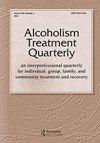当前和新兴的酒精和物质治疗研究
IF 0.9
Q4 SUBSTANCE ABUSE
引用次数: 0
摘要
在我们的41卷期刊的最后,我们精选了一些有趣而有用的研究、报告和作品。本卷的最后一期重点介绍了关于提供者和特殊人群在治疗和康复方面的研究。Belus及其同事介绍了他们在一项临床试验中的发现,重点是性或性别少数群体(SGM)状态如何影响治疗结果。这些研究人员在感染艾滋病毒的非裔美国人的主要失业人群中检查了一项以禁欲为重点的混合住院门诊药物使用治疗计划。该研究介绍了物质使用/再利用率的研究结果。性少数群体或性别少数群体(SGM)个体的识别率不同,因为SGM个体的重复使用风险增加。Bobak通过项目评估方法介绍了一份关于在疗养院完成的教育研讨会的简短报告。特别是,本次研讨会的重点是鼓励使用药物辅助治疗和NARCAN来预防和减少阿片类药物过量。介绍了参与者识别阿片类药物过量并采取措施扭转这种情况的能力。本报告提供了一个以社区为基础的组织实施一项新计划的例子,对其进行研究并专注于提高质量。Ricciutti报道了一项有趣的研究,该研究探讨了心理健康和化学依赖咨询师对接受SUD治疗的个人的污名化影响,并发现这两个职业的一系列参与者都对这一客户群体持有污名化。这表明需要了解污名的预测因素,以及它如何影响所提供的治疗质量。接下来,Thorkildsen和同行们报告了一项在线调查,该调查使用情景来评估心理健康支持工作者的康复观念和积极的风险承担方法。这组工作人员治疗同时患有精神疾病和药物使用障碍的客户。作者发现过分强调该领域常见的话题和技巧,包括厌恶和家长式策略。研究人员断言,以康复为导向的实践需要在心理健康环境中更彻底、更真实地实施。Namgyal Bhutia报告了印度一座城市药物使用障碍的流行情况。作者指出,相当多的死亡与药物使用有关,高比例的受访者确定了药物对自己社区的影响。介绍了有关污名化、承认和提高社区意识的概念。Hatch及其同事对被监禁人群中酒精严重程度指数(ASI)的使用提出了看法,并指出了评估中的几个缺陷,包括有效性、评估时间和检测窗口。作者还主张改善监狱人口的评估,重点是提高治疗效果。Ahmad及其同事报告了青少年早期饮酒的情况,并发现了父母饮酒量、剩余饮料的供应、育儿方式和同伴对酒精治疗的压力等因素,2023年第四季度,第41卷,第4期,371-372https://doi.org/10.1080/07347324.2023.2253513本文章由计算机程序翻译,如有差异,请以英文原文为准。
Current and Emerging Research for Alcohol and Substance Treatment
We conclude the 41 volume of our journal with a good selection of interesting and useful studies, reports and works. The final issue for this volume highlights studies on providers and special populations in treatment and recovery. Belus and colleagues present their findings from a clinical trial with a focus on how sexual or gender minority (SGM) status may influence treatment outcomes. These researchers examined an abstinence-focused mixed inpatient-outpatient substance use treatment program within a predominantly unemployed population of African Americans who were living with HIV. The research presents findings on substance use/reuse rates. The identified rates among individuals with a sexual or gender minority (SGM) status differed in that there was an increased risk of reuse among SGM individuals. Bobak presents a brief report, via program evaluation methodology, on an educational workshop completed in a recovery home. In particular, this workshop was focused on encouraging the use of medication-assisted treatments (MATs) and NARCAN to prevent and reduce opioid overdoses. Information is presented on participant abilities to identify an opioid overdose and take steps to reverse it. This report provides an example of a community-based organization implementing a novel program, subjecting it to research and focusing on quality enhancement. Ricciutti reports on an interesting study exploring the effect of stigma among mental health and chemical dependency counselors toward individuals treated for SUD, and found a range of participants in both professions holding stigma toward this client population. This showed a need to understand the predictors of stigma and how it may impact the quality of treatment provided. Next, Thorkildsen and peers report on an online survey that used scenarios to assess recovery perceptions and positive-risk taking approaches among mental health support workers. This group of workers treat clients with co-occurring disorders of mental illness and substance use. The authors found an overemphasis on topics and techniques common to the field including aversive and paternalistic strategies. The researchers asserted that recovery-oriented practices need a more thorough and authentic implementation within mental health settings. Namgyal Bhutia reported on the prevalence of substance use disorder in an Indian city. The authors noted a considerable number of deaths associated with substance use and a high percentage of respondents identified the impact of substances on their own communities. Concepts around stigma, acknowledgment, and increasing awareness within the community are presented. Hatch and colleagues offered a perspective on the use of Alcohol Severity Index (ASI) among incarcerated populations and noted several shortcomings in the assessment, including validity, time of assessment, and window of detection. The authors also advocate for improving assessment within the prison population with a focus on enhancing treatment outcomes. Ahmad and peers reported on early age alcohol initiation among adolescents and found factors such as parental alcohol consumption, availability of leftover drinks, parenting approach and peer pressure to ALCOHOLISM TREATMENT QUARTERLY 2023, VOL. 41, NO. 4, 371–372 https://doi.org/10.1080/07347324.2023.2253513
求助全文
通过发布文献求助,成功后即可免费获取论文全文。
去求助
来源期刊

Alcoholism Treatment Quarterly
SUBSTANCE ABUSE-
CiteScore
1.60
自引率
11.10%
发文量
31
期刊介绍:
Alcoholism Treatment Quarterly is an exciting professional journal for clinicians working with persons who are alcoholic and their families. Designed to bridge the gap between research journals and information for the general public, it addresses the specific concerns of professional alcoholism counselors, social workers, psychologists, physicians, clergy, nurses, employee assistance professionals, and others who provide direct services to persons who are alcoholic. The journal features articles specifically related to the treatment of alcoholism, highlighting new and innovative approaches to care, describing clinical problems and solutions, and detailing practical, unique approaches to intervention and therapy.
 求助内容:
求助内容: 应助结果提醒方式:
应助结果提醒方式:


